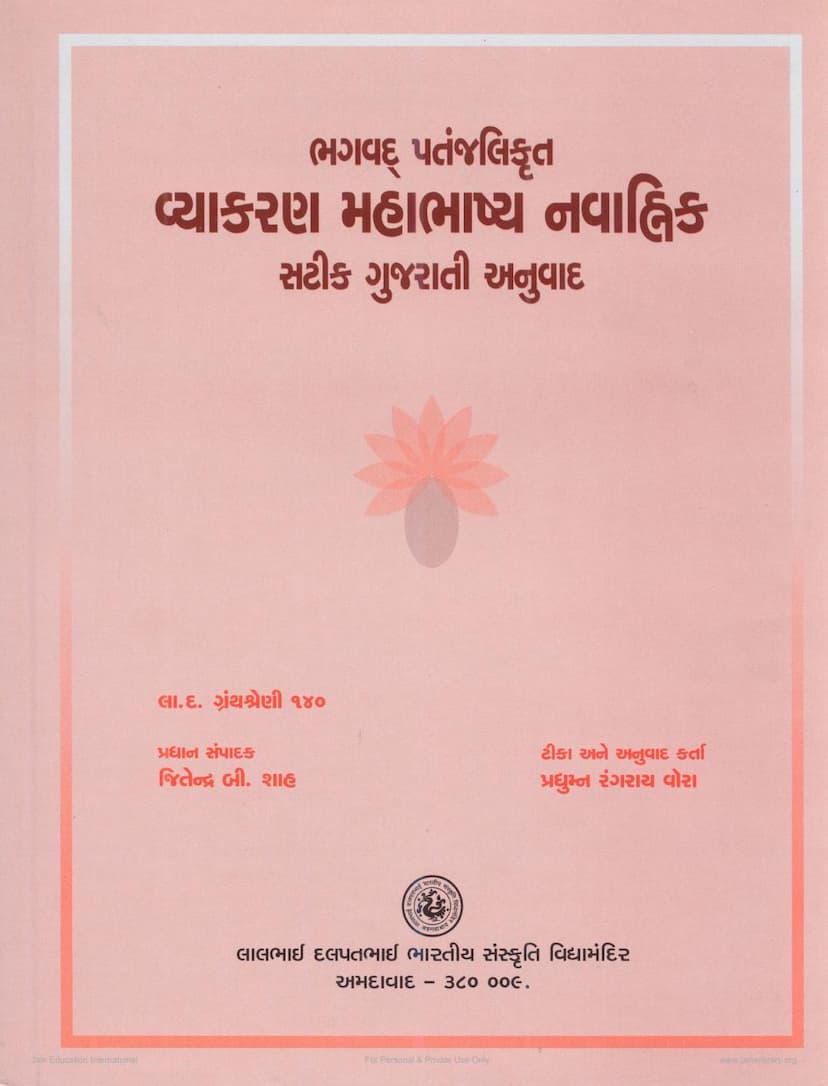Vyakaran Mahabhashya Navahnik Satik Gujarati Anuwad
Added to library: September 2, 2025

Summary
This comprehensive summary captures the essence of the provided Jain text, "Vyakaran Mahabhashya Navahnik Satik Gujarati Anuwad," by delving into its content and structure based on the provided pages.
Book Title: Vyakaran Mahabhashya Navahnik Satik Gujarati Anuwad Author: Pradyumna R Vora Publisher: L D Indology Ahmedabad Catalog Link: https://jainqq.org/explore/005538/1
Overall Summary:
This publication is a Gujarati translation and commentary on the first chapter, first pada, of the Vyakaran Mahabhashya, authored by Bhagvat Patanjali. The Mahabhashya is a foundational commentary on Lord Panini's Ashtadhyayi, the earliest available grammar of Sanskrit. The work aims to fill a long-felt gap for Sanskrit scholars and students in Gujarat by providing a detailed explanation and translation of the first nine Ahnikas (sections) of the Mahabhashya's first chapter. The text emphasizes the crucial role of grammar (Vyakaran) as the "mouth of the Vedas," essential for understanding language and its meaning. It highlights how subsequent grammars are indebted to Panini's work and how the Mahabhashya itself clarifies and elaborates upon Panini's meticulous and scientific approach to grammar.
Key Themes and Content (Based on the provided pages):
- Praise for Sanskrit and Grammar: The book begins by extolling the richness of Sanskrit literature, the highest repository of Indian culture, and underscores Sanskrit grammar as the key to understanding it.
- Panini's Ashtadhyayi and Patanjali's Mahabhashya: It positions Panini's Ashtadhyayi as the first comprehensive Sanskrit grammar, with Patanjali's Mahabhashya as its authoritative commentary.
- Importance of Grammar (Vyakaran): The text elaborates on why grammar is considered the most important of the Vedangas (auxiliary disciplines of the Vedas), as it governs the knowledge of words and their meanings. It quotes various authorities emphasizing grammar's primary role in understanding all scriptures.
- The "Navaahnika": The specific focus of this publication is the "Navaahnika," which refers to the first nine Ahnikas of the first chapter of the Mahabhashya, dealing with foundational concepts of grammar.
- The Nature of Language and Words: The text delves into discussions about the permanence of words and language, contrasting the ideas of permanence (nitya) and creation (karya). It also explores the meaning of "word" (Shabda), discussing whether it refers to the physical sound (dhvani), the abstract form (jati), or the individual instance (vyakti).
- Grammar's Purpose: It outlines the various purposes of studying grammar, including the protection of the Vedas, understanding complex Vedic rules for rituals (Karma), avoiding linguistic errors (aparadha), achieving clarity of expression, and ultimately, attaining spiritual merit and liberation.
- The Role of Vyakarana in Jainism (Implicit): While the text is primarily about Sanskrit grammar and Patanjali's Mahabhashya, its publication by L D Indology Ahmedabad and the mention of Jain Education International and Jainqq.org in the catalog link suggest a potential connection or interest within the Jain scholarly community in this foundational text of Vedic grammar. Jain philosophy also places immense importance on the correct understanding and usage of language, especially in religious texts and treatises.
- Historical Context and Previous Scholarship: The author, Pradyumna R Vora, acknowledges the inspirations and guidance received from various scholars and institutions, including Pandit Damsukhlal Malvaniya, Professor A.G. Bhatt, and others. He also mentions relying on various editions of the Mahabhashya, including Keller's edition and commentary from Kashinath Bhattacharya, and drawing upon the works of renowned grammarians and scholars like Kaiyata, Nagesh Upadhyay, Bhartrihari, and others.
- Methodology: The translation aims for literal accuracy while retaining original technical terms in Sanskrit where necessary, with explanations provided in the commentary. The author also notes the challenges of deciphering the original text and the potential for discrepancies compared to modern research.
- Structure of the Mahabhashya: The preface includes an index of the nine Ahnikas that comprise the discussed portion of the Mahabhashya, indicating the volume of material covered.
- Dedication: The book is dedicated to the author's parents, highlighting their role in its completion.
- Publisher's Note: The publisher expresses joy in releasing the translation, recognizing the importance of Sanskrit grammar and the need for a commentary on the Mahabhashya's "Navaahnika" due to its complexity.
In essence, this publication offers a scholarly bridge for Gujarati-speaking readers to access and understand a critical and complex text in the field of Sanskrit grammar, emphasizing its philosophical depth and practical application in understanding ancient Indian wisdom.